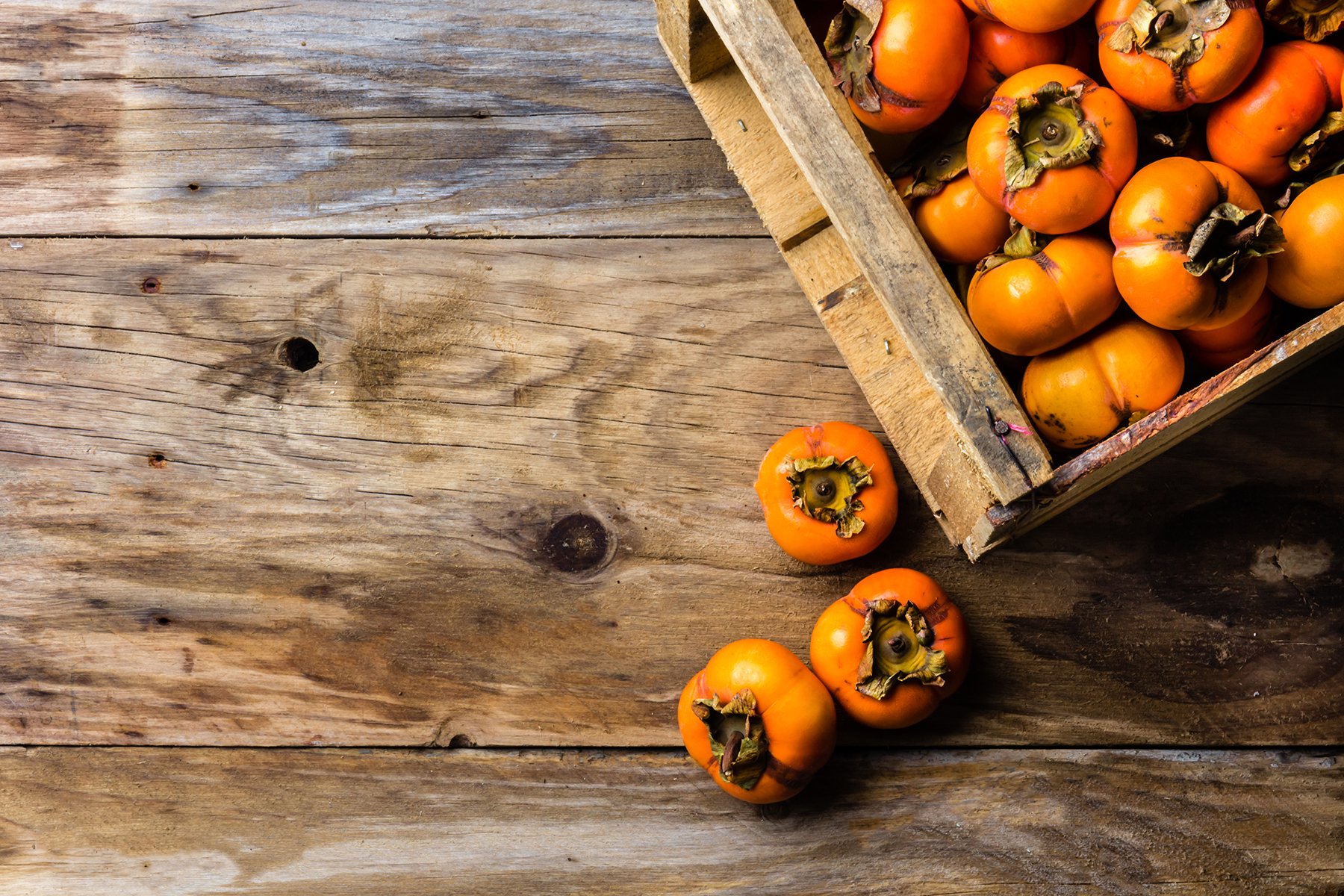Choke Fruit Anyone?

Possumwood (or persimmon wood) boasts the flavorful fall fruit persimmon, or “choke fruit,” as it is so fondly called (I’ll get to why it’s received this colorful nickname shortly), and is as old as the possum itself. Eaten for generations, the American persimmon (also known as the common persimmon) has been prized for its health benefits and versatility by natives and colonialists alike. It’s full of nutrients, such as vitamins A, C, E, and K, potassium, thiamin, riboflavin, and manganese; is an excellent source of powerful antioxidants; may boost heart health; may help reduce inflammation; is rich in fiber; and supports healthy vision. Foods, medicine, beer, and brandy are just a few things for which the choke fruit has been used over time. Once a little-known specialty fruit, the persimmon’s popularity has skyrocketed in recent years, making it a staple on many fall menus.
According to The Virginian Pilot, “the name ‘persimmon’ comes from the Powhatan word ‘putchamin,’ which loosely translates to ‘choke fruit.’” Not too friendly of monikers, I know. There are basically two types of the common persimmon – astringent and non-astringent (these don’t sound too appetizing, either, but don’t be scared). Both, when unripe, with their extreme bitterness and tannins, will suck the moisture completely out of your face – hence, the nickname “choke fruit.” But when ripened, both are sure to be likened to the sweetest apricot you ever tasted, earning the persimmon the colloquial name “fruit of the gods.” Generally matured in late November to early December, the now very popular common persimmon was a favorite for Native Americans who enjoyed it fresh off the tree or baked into bread. Europeans often referred to that same bread as persimmon pudding. The Asian persimmon, on the other hand, ripens in September and is sweeter and softer when ripe.
Part of the persimmon’s rise in popularity is due to its availability. The common persimmon has a huge growing area in America, ranging from Florida to the upper reaches of Connecticut, and the bulk being in the Appalachian area, including right here in North Carolina. According to NC State Extension (https://plants.ces.ncsu.edu/plants/diospyros-virginiana/), “It can be grown as an ornamental or fruit tree in the home landscape, or in naturalized areas for wildlife ...With spectacular autumn foliage and fruit that extends the harvest late into the fall, they are an excellent addition to an edible landscape. Fruit can stay on the tree after the leaves have fallen unaffected by freezing temperatures, giving an attractive addition to a winter garden.” So if you’re looking to add a bit of fall foliage and flavor to your garden, consider adding a persimmon tree or two to your landscape. But while waiting to enjoy the deliciousness of the persimmon from your newly planted possumwood tree, go ahead and visit your favorite grocery store or local farmers market this fall and pick up a few choke fruits that are perfect for fall dishes.
One of my favorites brandishing the beloved persimmon is called a pudding, but is actually more of a cake or a bread, like those enjoyed by the Europeans – this particular one being a rich, bread-like dessert. And for those who prefer their calories in liquid form, I’m also sharing a persimmon old fashioned. Whichever recipe you choose to enjoy, both are sure to warm you inside and out on a crisp autumn evening.
Persimmon Pudding
Serves 8
– ½ teaspoon baking soda
– 2 cups persimmon pulp
– 2½ cups white sugar
– 2 eggs, beaten
– 2 cups all-purpose flour
– 2 teaspoons baking powder
– ½ teaspoon ground cinnamon
– ¼ teaspoon vanilla extract
– 1 pinch salt
– 2½ cups milk
– 4 tablespoons melted butter
Preheat oven to 325 degrees. Grease a 9x13-inch baking dish. In a mixing bowl, combine persimmon pulp, baking soda, sugar, and eggs. Mix well. Add flour, baking powder, cinnamon, vanilla, salt, milk, and melted butter. Stir to combine. Pour into baking pan and bake in preheated oven for 55 minutes (the pudding will fall when removed from oven).
Serve warm or at room temperature. And if you feel so inclined, top off with a scoop of delicious vanilla ice cream.
Spiced Persimmon Bourbon Old Fashioned
Spice Maple Persimmon Puree:
– 2 ripe persimmons, chopped
– ½ cup real maple syrup
– 1 cinnamon stick, plus more for serving
Old Fashioned:
– 2 ounces bourbon
– 1 ounce lemon juice
– Juice from 1 clementine
– 1 dash orange bitters
– 1-2 tablespoons of the puree
– Sparkling water, for topping (optional)
– Star anise and cinnamon (optional)
To make the puree, combine the persimmons, maple syrup, ½ cup water, and cinnamon stick in a small pot. Set over medium heat and bring to a boil. Cook 5-8 minutes or until the persimmons are mushy and have released their juices. Remove from heat. Remove the cinnamon stick and puree the mix. Let cool. The puree will keep for one week in the fridge.
To make the old fashioned, combine the bourbon, lemon juice, clementine juice, orange bitters, and 1-2 tablespoons of the spice maple persimmon puree in a cocktail shaker. Shake to combine. Strain into a glass, and if desired, top with sparkling water and garnish with cinnamon and star anise.
Buck Buchanan
Owner of Lumpy's Ice Cream. Lumpy's uses the finest local ingredients and crafts them into ice cream without any preservatives, additives, or synthetic hormones.

